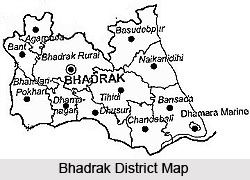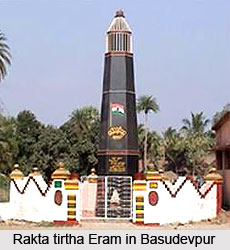 Bhadrak District is an administrative district of Orissa, lying in eastern India. Bhadrak town is the district headquarters. Bhadrak subdivision of the undivided Balasore District became a new district on 1st April, 1993. Bhadrak having a rich heritage and history derives its name as legend has it, from Goddess Bhadrakali whose temple stands on the bank of the river Salandi. This district is bounded by Balasore district in the north, Jajpur district and river Baitarani is in the south, Keonjhar district is in the west and Bay of Bengal and Kendrapada district is in the east. Total area covered by Bhadrak District is 2,677 sq kms. As per 2001 Census, total population of the district is 1,332,249. It is a level tract of alluvial soil with a gradual slope eastwards to the Bay of Bengal. The language mostly spoken by the people of Bhadrak district is Oriya language.
Bhadrak District is an administrative district of Orissa, lying in eastern India. Bhadrak town is the district headquarters. Bhadrak subdivision of the undivided Balasore District became a new district on 1st April, 1993. Bhadrak having a rich heritage and history derives its name as legend has it, from Goddess Bhadrakali whose temple stands on the bank of the river Salandi. This district is bounded by Balasore district in the north, Jajpur district and river Baitarani is in the south, Keonjhar district is in the west and Bay of Bengal and Kendrapada district is in the east. Total area covered by Bhadrak District is 2,677 sq kms. As per 2001 Census, total population of the district is 1,332,249. It is a level tract of alluvial soil with a gradual slope eastwards to the Bay of Bengal. The language mostly spoken by the people of Bhadrak district is Oriya language.
History of Bhadrak District
Bhadrak District is an ancient land noted in legends dating from the age of the Indian Puranas, contributing to Orissa`s maritime and agrarian prosperity, trade and commerce down the ages and recorded in history. After the British occupation of Orissa, Cuttack and Balasore constituted one of the two administrative divisions, in June 1804. In 1828 when Balasore was made a separate district, Bhadrak became one of its sub-division with an Assistant Magistrate cum Deputy Collector as the Sub-Divisional Head, while the Munsif Court remained in Jajpur until 1901. In modern times, during the period of National struggle Bhadrak became the forerunner. In the historic Quit India Movement of 1942 Bhadrak played a leading role. Since independence, the history of Bhadrak District has been the history of diverse progress in spheres like education, industry, agriculture, trade and commerce. This district was carved out from Balasore District and became a separate entity on 1st of April 1993.
Geography of Bhadrak District
Bhadrak District is divided into three zones according to its soil condition namely Saline Soil, Alluvial Soil and Sandy Soil. Geography of Bhadrak District is divided into two well-designed tracks and these are the salt tracks along the coasts which are not arable and the arable track, which is called the granary of the state. As per the agro climatic condition of the district the areas are divided into four zones. These zones are Rain fed zone, Perennial irrigated zone, Flooded Zone and Saline zone. There are five types of forests in Bhadrak district. The climate of this district is generally hot with high humidity. May is the hottest month. December is the coldest month of this district. A number of deltaic rivers namely Salandi, Baitarani, Kansabansa, Gamol, Mantei, Genguti, Kochila, Reba and Kapali pass through Bhadrak District. The rivers are seasonal.
Administration of Bhadrak District
 Administration of Bhadrak District comprises one sub-division that is Bhadrak. Total number of tehsils in Bhadrak District is seven namely Basudevpur, Bonta, Bhadrak, Chandbali, Dhamnagar, Tihidi and Bhandaripokhari. There are 193 Gram Panchayats in Bhadrak District and 1356 revenue villages.
Administration of Bhadrak District comprises one sub-division that is Bhadrak. Total number of tehsils in Bhadrak District is seven namely Basudevpur, Bonta, Bhadrak, Chandbali, Dhamnagar, Tihidi and Bhandaripokhari. There are 193 Gram Panchayats in Bhadrak District and 1356 revenue villages.
Economy of Bhadrak District
Economy of Bhadrak District is hugely dependent on agriculture and allied activities as agriculture is the main income of the district. But many people in the sea cost area (Dhamara, Chudamani of Basudevpur and Chandabali area of Chandabali Block) depend on fishing. Thus, it is another sector that contributes to the economy of Bhadrak District. Paddy is grown as the main crop in Kharif, which constitutes around 94 percent of the total cultivable area. During Kharif season about 47 percent of cultivable area is rain fed and likely to remain exposed to the gambling monsoon and natural calamity. Around 9 percent of the total cultivable area is up-land, 36 percent is medium land and 55 percent is low land.
Tourism in Bhadrak District
There are several tourist attractions in Bhadrak District. Bhadrak town is situated at a distance of 159 km from the state capital, Bhubaneswar. The famous Bhadrakali Temple in this town is visited by thousands of pilgrims across the year. Aradi, Chandabali, Dhamanagar, Dhamara, and Guamala Nuasasan are some other places of tourist interest in Bhadrak district. Rakta tirtha Eram in Basudevpur is a historic place that is worth exploring. Brahmangan is another village in Basudevpur constituency of Bhadrak district that is famous for its century old Prasanna Khemeswar Mahadeva temple.
Bhadrak District has several important schools, colleges and hospitals thus ensuring a developed lifestyle.






